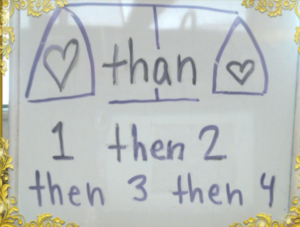How to use Scaffolding while Teaching ESL Online
Scaffolding is an important teaching technique that ensures the student can meet lesson objectives. You can think of a building’s scaffolding as a metaphor. While building, scaffolding provides support until the building can stand on its own. While teaching, scaffolding supports the student until they can produce the content on their own.
You can scaffold up or scaffold down.
You can also scaffold vocabulary by being aware of the 3 tiers of vocabulary.
ESL Teachers can scaffold down if a student needs more support.
Scaffolding in ESL Classes through the PPP approach
A common ESL lesson plan structure that utilizes scaffolding is the PPP approach (Present, Practice, Produce).
Some refer to this lesson plan structure as the “I do, we do, you do” approach. Whatever you call it, the strategy is simple. First, you present or show or model how to do something. Then, you guide the student and practice it together. Finally, you release the student and they produce or create or use the new knowledge on their own.
Good ways to scaffold down while teaching ESL to students
- Give the student a sentence frame to use
- Model activities by completing them for the student first
- First, read a passage to the student, then have the student read it with support, then have them read it independently
- Using TPR or props to remind students of vocabulary is a simple scaffolding method, too

How to Scaffold Up for ESL Students
ESL teachers can use scaffolding up to increase student independence when the student is at a higher level than the lesson.
Good ways to scaffold up while teaching ESL to students
- Ask the student to explain the vocabulary word in their own words
- Ask the student to create new sentences with the new words they learned
- Ask the student to create their own TPR or props for words
- Use known sentence frames to discuss other topics.
Bottom Like: Scaffolding is a helpful teaching technique in which the teacher helps the student progressively acquire skills until they become independent. You can scaffold up or scaffold down by working within the following frameworks: 3 tiers of vocabulary, use the “I do, we do, you do” approach, or the PPP approach (Present, Practice, Produce).
Related Keywords: scaffolded instructions, weak learners, Lev Vygotsky, the Zone of Proximal Development (ZPD), explicit instruction, scaffolded instructional strategies for ells, sentence frames, Schema Building, modeling, tiered vocabulary
Sources
Teaching Strategy: I Do, We Do, You Do. (2013, October 7). Retrieved October 12, 2015, from https://www.youtube.com/watch?v=E08qf20yGv8
https://www.fordham.edu/download/downloads/id/4912/scaffolding_strategies_for_ells.pdf











